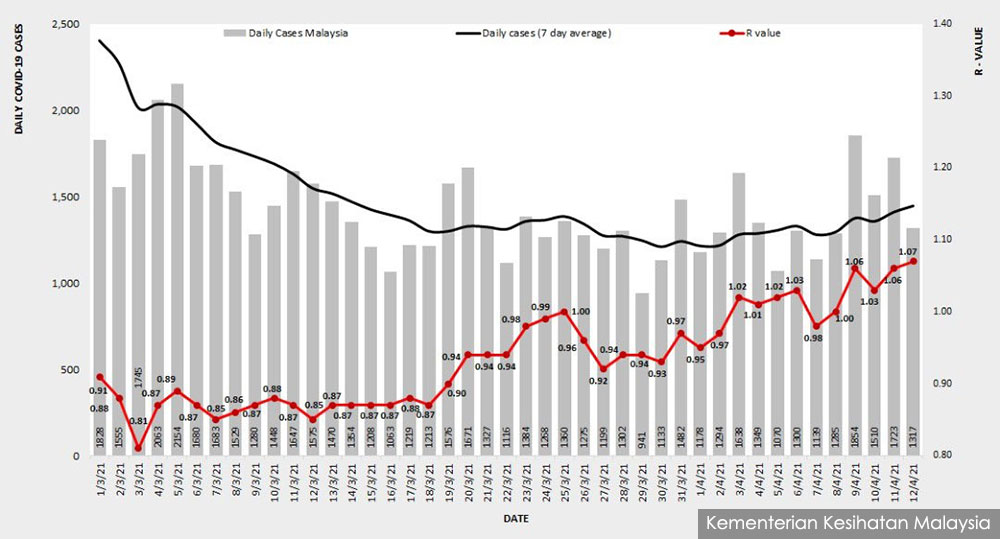Although the third wave of the Covid-19 outbreak in Malaysia has yet to subside, Malaysians are already venturing out from their homes more often than any other time since the movement control order (MCO) was implemented on March 18 last year.
Handphone mobility data shows that as of the end of March, it was only two percent below levels typically seen before the pandemic. The uptick came just weeks before Malaysia started seeing a reversal in its gains against the outbreak in recent months.
The data was compiled by the Institute for Health Metrics and Evaluation located at the University of Washington, Seattle, USA, and is based on anonymised mobility data from Google, Facebook and Apple.
These tech giants had gathered anonymous location data from their users and provided it to researchers and policymakers to help their Covid-19 responses.
The location data is used as an indirect yardstick for the extent to which social distancing is being practised, which in turn is a key measure for preventing the spread of the disease.
According to the IHME data, mobility fell to as low as 44 percent below normal levels following the introduction of the second MCO in some states and territories in January this year, as the pandemic threatened to overwhelm Malaysia's healthcare system.
Nevertheless, the rules were gradually relaxed, with one sector of the economy after another granted exemptions to continue operations.
Defence Minister Ismail Sabri Yaakob had said this was done to strike a balance between protecting people's health and the economy.
By Feb 14, mobility started shooting up over the next few weeks, just a few days before a 10-kilometre limit on travel was lifted because "more activities and businesses have resumed operations", and the limit no longer deemed "relevant".
This also coincided with a steady drop in the number of cases – only 2,464 cases were reported on Feb 14, compared to the peak of 5,728 cases on Jan 30.
The Covid-19 effective reproduction number (Rt) that day was 0.89 according to Health Ministry data, which is consistent with an outbreak in decline.
Rt is a measure of a disease's infectivity. An Rt of 1.00 indicates a steady increase in the number of cases, whereas any number above that indicates an outbreak that is accelerating in growth.

Mobility increased from 41 percent below normal on Feb 14 to 23 percent below normal by the end of the month. It continued its rise to just two percent below the normal level as of the latest available data on March 31, where it was still on the uptrend, with no signs of slowing.
For comparison, even in the middle of last year when Malaysia had few Covid-19 cases, mobility was still seven percent below pre-pandemic levels or less.
By late March this year, however, the country's gains against the Covid-19 outbreak was starting to show signs of reversal.
The number of active cases began to grow again, and Rt reached 1.00 on March 25 for the first time since Feb 4.
As for yesterday, new cases continued to outpace recoveries, with 1,317 new cases detected and an Rt of 1.07, adding pressure to Malaysia's healthcare system.
Meanwhile, Google's weekly mobility report provides insight into what types of places are being visited by Malaysians during the pandemic.
It shows that movements in the "residential" category are in decline since the beginning of the year, whereas all other categories are on the uptrend up to April 7, where the latest data is available.
People are spending eight percent more time at home compared to pre-pandemic levels on April 7, according to Google mobility data compiled by the website Our World in Data, which is a decline from the 21.43 percent on Feb 14.
Conversely, grocery and pharmacy stores see an increasing number of visits, up to 9.29 percent above pre-pandemic norms.
Retail and recreation, workplaces, parks, and transit stations have also seen increasing visits since mid-February, albeit still below pre-pandemic levels.
For the record, Google mobility data measures the "residential" category by the amount of time spent in such places by Google Maps users that have consented to share their data, whereas all other categories are measured by the number of visits by the users to such places.
Hence, the residential data is not directly comparable to the other categories.
The data presented in Our World in Data is also averaged over seven days to smooth out sudden fluctuations in the data compared to Google's raw data.
- Mkini



No comments:
Post a Comment
Note: Only a member of this blog may post a comment.